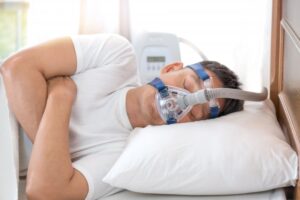
Sleep apnea, once considered a relatively obscure sleep disorder, has become a topic of growing public health concern—and for good reason. In recent years, sleep apnea diagnoses have surged, prompting researchers and healthcare providers to examine the underlying causes behind the rise. The data suggests that sleep apnea is not only being recognized more frequently but is also becoming more prevalent due to a variety of health and lifestyle trends.
First, a little background before a deeper dive into the reasons behind this increase.
What is Sleep Apnea?
Sleep apnea is a condition characterized by repeated interruptions in breathing during sleep. The most common form, obstructive sleep apnea (OSA), occurs when the muscles in the throat relax excessively, blocking airflow. These breathing pauses can lead to fragmented sleep, low oxygen levels, and a host of health complications, including high blood pressure, heart disease, and cognitive issues.
The Rising Numbers
Recent studies indicate that sleep apnea affects nearly 1 in 5 adults to some degree, and that number appears to be climbing. While increased awareness and improved diagnostic methods are partly responsible, they don’t account for the full picture. According to global health data, the rise in sleep apnea is real and not just the result of better detection.
Contributing Factors
Several key factors are driving the upward trend in sleep apnea cases.
Obesity Epidemic
Obesity is one of the strongest risk factors for sleep apnea. Excess weight, especially around the neck and abdomen, can contribute to airway obstruction during sleep. With obesity rates continuing to climb globally, it’s no surprise that sleep apnea is becoming more common.
Aging Population
As people age, their risk of developing sleep apnea increases. Aging muscles in the airway are more prone to collapsing, which can contribute to breathing disturbances. With longer life expectancies and a growing population of older adults, more individuals are likely to experience sleep apnea symptoms.
Lifestyle and Environmental Changes
Modern lifestyles that promote sedentary behavior, poor diets, and increased stress may also play a role. Additionally, some studies suggest that rising nighttime temperatures due to climate change may impact sleep quality and breathing patterns, potentially exacerbating sleep disorders like apnea.
Why It Matters
Sleep apnea doesn’t just affect sleep—it impacts overall health and well-being. People with untreated sleep apnea often suffer from daytime fatigue, irritability, memory problems, and an increased risk of chronic diseases. In severe cases, sleep apnea can even be life-threatening.
The growing prevalence of sleep apnea also places a burden on healthcare systems. The condition is linked to higher rates of hospitalization, increased medical costs, and lost productivity at work.
What You Can Do
If you suspect you or a loved one has sleep apnea, don’t ignore the signs. Loud snoring, gasping for air during sleep, and persistent daytime sleepiness are red flags. A sleep study can help diagnose the condition, and treatments such as CPAP therapy, oral appliances, and lifestyle changes can significantly improve symptoms.
Yes, sleep apnea is on the rise, and it’s a trend that deserves attention. By understanding the risk factors and taking steps to address symptoms early, individuals can protect their health and improve their quality of life.
About the Author
Dr. Shelley D. Shults is board certified as a general dentist, a family nurse practitioner, and a dental sleep medicine practitioner. She is a 2001 graduate of The Ohio State University and was awarded diplomate status by the American Academy of Dental Sleep Medicine in 2015. In addition to regularly lecturing on the dangers of sleep apnea, Dr. Shults stays current in her field through memberships in the American Dental Association, the Ohio Dental Association, and the American Academy of Sleep Medicine. If you suspect you may have sleep apnea, schedule your appointment online with us or call (614) 396-9310.
